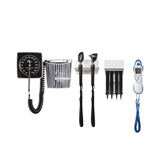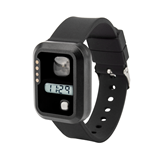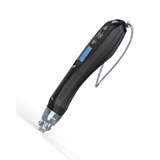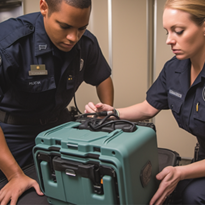I. Introduction
Portable ultrasound machines have become essential tools in modern medical practice, revolutionizing the way healthcare professionals diagnose and monitor patients.This comprehensive buying guide aims to provide valuable insights and expert recommendations for selecting the right portable ultrasound machine for point-of-care diagnostics.As advancements in technology continue to drive the development of medical devices, portable ultrasound machines offer a myriad of benefits that cater to various clinical specialties and applications.Whether you are a physician, a nurse, or a medical practitioner, understanding the key features, considerations, and functionalities of these devices is crucial in making an informed purchasing decision.
A. Importance of Portable Ultrasound Machines in Medical Practice
Portable ultrasound machines have gained immense significance in medical practice due to their versatility and convenience. They enable medical professionals to perform real-time imaging at the patient's bedside, in remote locations, and even during emergency situations, offering immediate insights into a patient's condition . The non-invasive nature of ultrasound examinations makes them preferable for various patient groups, including pregnant women, children, and individuals with specific medical conditions. These devices have the potential to enhance patient care by facilitating faster diagnosis and reducing the need for more invasive and costly procedures. Moreover, portable ultrasound machines play a vital role in resource-limited settings, providing access to medical imaging in areas with limited infrastructure or during disaster relief efforts.


Find the right Portable Ultrasound Machine
Compare quotes from expert Australian suppliers and make the best choice. It's free, quick and easy!
II. Understanding the Advantages of Portable Ultrasound Machines in Medical Practice
Portable ultrasound machines have revolutionized medical practice by providing healthcare professionals with a versatile and efficient tool for point-of-care diagnostics. These devices offer numerous advantages that significantly impact patient care and clinical workflows. In this section, we will delve into the key benefits of using portable ultrasound machines in medical settings.
A. Enhanced Point-of-Care Diagnostics:
Immediate Imaging: Portable ultrasound machines enable real-time imaging, allowing healthcare providers to visualize internal structures and make quick assessments at the bedside or in the field.Rapid Diagnoses: With the ability to perform immediate scans, medical professionals can promptly diagnose conditions, initiate treatment plans, and make critical decisions without delays.Informed Decision-Making: Portable ultrasound provides valuable insights into patient conditions, facilitating accurate diagnoses and guiding appropriate treatment pathways.
B. Improved Patient Care and Accessibility:
Bedside Imaging: Portable ultrasound machines bring imaging capabilities directly to the patient's bedside, reducing the need for patient transfers and minimizing discomfort.
Point-of-Care Versatility: These devices can be used in various clinical settings, including emergency departments, clinics, ambulances, and remote locations, ensuring accessibility to quality care.Enhanced Patient Communication: Real-time imaging empowers healthcare providers to visually explain medical conditions to patients, improving patient understanding and engagement in their own care.
C. Cost-Effectiveness and Efficiency:
Reduced Imaging Costs: Portable ultrasound can serve as a cost-effective alternative to larger imaging modalities, minimizing the expenses associated with traditional radiology services.Streamlined Workflows: The portability and ease of use of these machines contribute to efficient clinical workflows, saving valuable time for both medical professionals and patients.Point-of-Care Revenue: By offering immediate imaging services, healthcare facilities can potentially increase revenue streams through point-of-care billing and improved patient throughput.The advantages of portable ultrasound machines extend beyond these points and continue to drive their integration into modern medical practice. In the following sections, we will explore the clinical applications and specialties where these devices excel, the essential features that influence their performance, and factors to consider when selecting the most suitable portable ultrasound machine for specific healthcare needs.
III. Assessing the Clinical Applications and Specialties for Portable Ultrasound
Portable ultrasound machines have revolutionized medical practice by providing point-of-care diagnostics in various clinical applications and specialties. Here, we explore the key areas where these devices have proven to be invaluable:
A. Emergency Medicine and Critical Care
- Rapid assessment of trauma patients in emergency settings
- Guided procedures, such as central line placement and nerve blocks
- Detection of internal bleeding and organ injuries in critical care scenarios
B. Obstetrics and Gynecology
- Prenatal care, including fetal heartbeat monitoring and gestational age estimation
- Evaluation of reproductive health issues, such as ovarian cysts and uterine abnormalities
- Guided procedures for amniocentesis and embryo transfer
C. Primary Care and Family Medicine
Point-of-care diagnosis and monitoring of various conditions, including abdominal pain and urinary tract issues Quick assessment of joint and soft tissue injuries. Detection of cardiac abnormalities, such as pericardial effusion or cardiac wall motion abnormalities
D. Musculoskeletal and Sports Medicine
- Assessment of sports-related injuries, such as muscle strains and ligament tears
- Visualization of joint inflammation and arthritis.Guidance for corticosteroid injections and other therapeutic procedures
IV. Key Features to Consider in Portable Ultrasound Machines
When selecting a portable ultrasound machine for your medical practice, it's crucial to assess various features that can impact its utility and performance. Here are the key considerations:
A. Imaging Modes and Quality (2D, 3D, Doppler, etc.)
- High-quality 2D imaging for general diagnostic purposes
- 3D and 4D imaging capabilities for detailed volumetric visualization
- Doppler imaging for assessing blood flow and vascular conditions
B. Transducers and Their Versatility
Different transducer types for various clinical applications (e.g., linear, convex, phased array). The broad frequency range for imaging superficial and deep structures.Specialty transducers for specific procedures, like endocavitary transducers for gynecological exams
C. User Interface and Ease of Operation
Intuitive and user-friendly interface for efficient navigation and control. Customizable presets for different clinical scenarios.Fast boot-up and setup times to streamline point-of-care use
D. Image Storage and Documentation Options
Sufficient internal storage capacity for storing images and patient data.Seamless integration with electronic medical record (EMR) systems.Ability to export images and reports in standard formats for easy sharing and archiving


Find the right Portable Ultrasound Machine
Compare quotes from expert Australian suppliers and make the best choice. It's free, quick and easy!
V. Examining Portability, Battery Life, and Ease of Use for Mobile Imaging
A. Size, Weight, and Portability Factors:
The physical dimensions of a portable ultrasound machine play a crucial role in its usability and versatility in point-of-care settings. Compact and lightweight devices are preferred as they offer ease of transportation and maneuverability during examinations. Portable ultrasound machines with a slim profile can easily fit into tight spaces and allow healthcare professionals to conduct scans in challenging environments. Consider the weight of the device, as it can impact the comfort of the operator, especially during prolonged use. Bulky or heavy machines may lead to user fatigue and hinder the efficiency of medical practitioners.
B. Battery Life and Power Management:
The battery life of a portable ultrasound machine is of utmost importance, as it directly influences its mobility and uninterrupted operation. Long-lasting batteries are essential for conducting multiple scans without the need for frequent recharging. Some advanced models may come with hot-swappable batteries, enabling continuous imaging by replacing depleted batteries with fully charged ones. Efficient power management features, such as automatic power-off during periods of inactivity, help conserve battery life and extend the overall operational time. Understanding the battery specifications, including charging time and capacity, assists in assessing the device's suitability for specific clinical requirements.
C. Ergonomics and User-Friendly Design:
Ergonomics plays a vital role in ensuring the comfort and ease of use for medical professionals operating portable ultrasound machines. Devices with well-designed user interfaces and controls facilitate intuitive navigation and reduce the learning curve for new users. Consider the layout of buttons, dials, and touchscreens to ensure quick access to essential functions during examinations. Adjustable displays that allow users to modify the viewing angle and brightness enhance the user experience and optimize visibility in various lighting conditions. Ergonomic transducer designs and cable management systems contribute to better handling and reduce strain on the operator's hand and arm during scanning.
VI. Connectivity and Data Management Capabilities of Portable Ultrasound Devices
A. Wireless Connectivity and Integration with EMRs:
Wireless connectivity features enable seamless integration of portable ultrasound machines with electronic medical record (EMR) systems. The ability to transmit imaging data and patient information directly to the EMR enhances workflow efficiency and reduces the chances of manual data entry errors. Secure Wi-Fi and Bluetooth connectivity protocols ensure data privacy and compliance with healthcare regulations. Look for compatibility with existing hospital or clinic networks to ensure smooth data sharing and collaboration among healthcare professionals.
B. Image and Data Transfer Options:
Portable ultrasound devices equipped with versatile data transfer options offer convenience in managing patient information and imaging records. USB ports and memory card slots allow quick and easy transfer of images and data to external storage devices. Some models may support cloud-based storage solutions, enabling secure access to patient records from multiple locations and devices. Consider the compatibility of data formats to ensure that the exported files can be easily viewed and analyzed on various platforms and software applications.
C. Security and Privacy Considerations:
When dealing with sensitive patient data, security is of paramount importance. Portable ultrasound machines with robust data encryption and authentication mechanisms safeguard patient privacy and protect against unauthorized access. Ensure that the device complies with relevant data protection regulations and industry standards to mitigate potential security risks. Regular software updates and firmware patches provided by manufacturers help address security vulnerabilities and ensure the continued protection of patient data.
VII. Budgeting and Cost Analysis for Portable Ultrasound Machine Purchase
A. Initial Investment vs. Long-Term Benefits:
Portable ultrasound machines may have a higher initial cost compared to traditional systems, but they offer substantial long-term benefits. Consider the potential cost savings from reduced patient referrals to imaging centers or hospitals, as point-of-care diagnostics can expedite treatment decisions. Evaluate the improved patient outcomes and satisfaction that may result from timely and accurate diagnoses, leading to potential cost reductions in follow-up care.
B. Cost of Transducers and Accessories:
Transducers are essential components of portable ultrasound machines and can vary significantly in price based on their frequency, applications, and quality. Evaluate the clinical needs of your practice to determine the required transducer types and choose cost-effective options without compromising diagnostic accuracy. Consider accessory costs such as protective cases, additional batteries, and portable carts, which may be necessary for optimizing the usability and durability of the device.
C. Maintenance and Support Expenses:
Factor in the maintenance costs associated with the portable ultrasound machine to ensure its optimal performance over time. Inquire about the manufacturer's recommended maintenance schedule and associated expenses, such as software updates, calibration, and periodic servicing. Research the availability and responsiveness of customer support services provided by the manufacturer or supplier, as efficient support can minimize downtime and potential disruptions to your medical practice.
VIII. Evaluating Brands and Models of Portable Ultrasound Machines for Quality and Reliability
A. Researching Reputable Brands and Manufacturers:
Conduct thorough research to identify established and reputable brands known for manufacturing reliable and high-quality portable ultrasound machines. Consider the manufacturer's experience in the medical imaging industry and their track record in producing cutting-edge diagnostic equipment. Look for certifications and regulatory approvals, as they indicate adherence to quality standards and compliance with relevant regulations.
B. Reading User Reviews and Expert Opinions:
Seek out user reviews and feedback from healthcare professionals who have hands-on experience with the specific brands and models you are considering.User reviews can offer valuable insights into the real-world performance, usability, and reliability of the portable ultrasound machines. Additionally, consult expert opinions and reviews from reputable medical publications or organizations to gain a comprehensive understanding of the device's strengths and limitations.
C. Considerations for Warranty and Customer Support:
Review the warranty coverage offered by different manufacturers, including the duration and extent of coverage for the portable ultrasound machine. A comprehensive warranty can provide peace of mind and financial protection in case of unexpected malfunctions or defects.
In conclusion, the selection of a portable ultrasound machine for point-of-care diagnostics requires a thoughtful and informed approach. The benefits of these devices in modern medical practice are vast, offering immediate imaging capabilities at the patient's bedside, enhancing patient care, and improving clinical workflows. The diverse clinical applications and specialties that benefit from portable ultrasound underscore their versatility and potential to transform patient outcomes.














